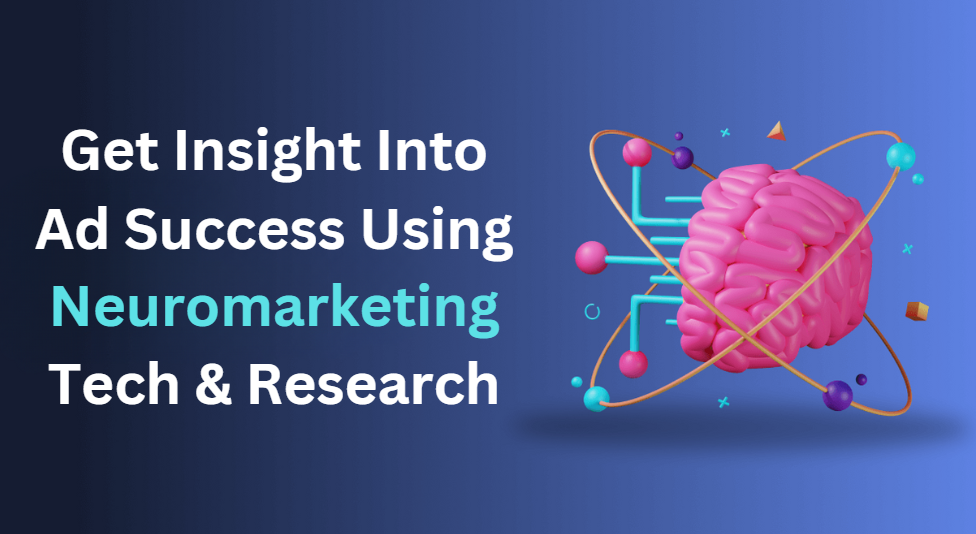Neuromarketing: What it is, and What it is Not
Neuromarketing is the study of how people interact with persuasive advertising. It combines psychology and neuroscience to understand how the human brain responds to marketing efforts. It is an investigative tool used by marketers to identify what works and what doesn’t, to maximize the effectiveness of their campaigns.
At the core of neuromarketing is understanding human decision-making. To create strong persuasive advertising, neuromarketers must comprehend why and when a person is most likely to take action. They use techniques such as facial coding, eye tracking, EEG (electroencephalography) and fMRI (functional magnetic resonance imaging) to measure reactions and responses to advertisements.
Neuromarketing is not a gimmick or a one-size-fits-all solution for advertisers. Marketers should always ensure they conduct consumer research prior to creating their campaigns.
Neuromarketing is an in-depth approach that requires careful consideration of consumer behaviour, cultural and social influences, and current trends. It requires a comprehensive strategy to determine how best to reach and engage your target audience.
When used correctly, neuromarketing is a powerful tool that can give businesses an edge over their competitors. Effective marketing requires understanding both the psychology and the neuroscience behind why people take action. Neuromarketing helps marketers identify and capitalize on these insights.
Explaining How Humans Make Decisions & the Psychology Behind It
Humans make decisions every day. Every action, both big and small, requires a decision. We make these decisions based on our emotions, thoughts and past experiences. But how do we come to these decisions? To better understand the psychology behind why humans make decisions, we must first understand the decision-making process.
The decision-making process is made up of steps that humans will typically go through when deciding between two or more options. The first step is recognition. This is when we recognize that a decision must be made. Next, we brainstorm and weigh out our options. Our brains then take into account all of the pros and cons of each option before we decide on our final course of action. Finally, we learn from our decision and take any necessary action.
Psychologists have long studied how humans make decisions and it has been found that we are heavily influenced by our emotions. Studies have found that humans have a tendency to rely on their gut feeling when making decisions, even if it goes against what would seem to be logic. This can be powerful when it comes to Neuromarketing, as understanding how people feel about something can inform the emotions that you are trying to evoke in your advertising campaigns.
Additionally, humans are influenced by social proof. This is the idea that people are more likely to act in a certain way if they see other people acting that way. This is why many websites will display reviews from customers, or why companies might feature influencers promoting their products. By showcasing others using a product or engaging with a service, companies can tap into consumers’ feelings of wanting to “fit in”, which can significantly influence their decision making.
Ultimately, understanding the psychology behind why humans make decisions can be incredibly useful when it comes to marketing and advertising. By understanding the decision-making process, marketers can craft campaigns that not only appeal to the needs of their target audience, but can also tap into their emotions and desires.
What are Neuromarketing Techniques?
Neuromarketing is a field of marketing that uses brain and cognitive science to understand how people make decisions. It applies research methods from psychology and neuroscience such as fMRI and EEG to study consumer behavior in order to gain insight into people’s buying patterns. By understanding consumer behavior, marketers are able to create more effective advertising and increase conversions.
Techniques used in neuromarketing vary depending on the research question being studied. Some of the most common techniques include:
- fMRI – Functional Magnetic Resonance Imaging uses magnetic fields to measure changes in blood-oxygen levels in the brain. It can be used to measure emotions or reactions to visuals.
- EEG – Electroencephalography measures electrical activity in the brain and is used to assess emotional responses to advertising.
- Eye Tracking – Eye tracking is used to determine where a person is looking while viewing a website or product. The data collected can be used to understand how users interact with design elements or product packaging.
- Facial Coding – Facial coding is used to measure nonverbal reactions such as smiles or frowns. This technique is often used to evaluate how people are responding to video or TV advertisements.
- Surveys – Surveys are used to ask consumers questions about their experiences with products and services. Survey data can then be analyzed to better understand consumer preferences and patterns.
These techniques can provide valuable insights to help marketers better understand customer needs and design more effective campaigns.
The Importance of Consumer Research in Advertising
Advertising is one of the most powerful tools available to marketers. While traditional marketing techniques rely on surface-level understanding of consumer needs, advertising allows marketers to go deeper in learning about their target audience. This is why conducting consumer research before engaging in advertising is so important.
Consumer research helps marketers identify what drives consumer behaviour and provides valuable insights into why customers make certain decisions. Marketers can use this information to develop an effective advertising strategy by focusing on key messaging and creative elements that will resonate with their target audience. By understanding what motivates a customer, a marketer can create a message that will more effectively elicit a desired response.
To gain a better understanding of their target audience, marketers should consider conducting primary research. This involves collecting data directly from customers through surveys, focus groups, interviews, or other methods. This type of research can provide marketers with valuable information about customer preferences, trends, and buying habits. Additionally, it can be used to evaluate current and potential advertising campaigns.
Participation in secondary research gathering activities can also be useful for marketers. This type of research involves collecting publicly-available data, such as industry studies or reports. Additionally, trends in search engine queries or social media conversations can also provide valuable insights. This type of research can help marketers keep up with changes in consumer behaviour and adjust their strategies accordingly.
Overall, conducting consumer research is an essential step in any effective advertising strategy. Marketers can use the information gathered from research to improve their campaigns and reach their target audience more effectively. By understanding what motivates customers to make a purchase, marketers can craft more persuasive messages that will persuade customers to take action.
The Benefits and Limitations of Neuromarketing
Neuromarketing is the science behind understanding how consumer brains respond to persuasive advertising. This is often used by advertisers to better understand how people make decisions, what influences them, and ultimately how to craft more effective messages for their products and services. Although there are many advantages to using neuromarketing, it’s important to understand its potential limitations as well.
Benefits of Neuromarketing
Using neuromarketing can be quite beneficial for marketers. By tapping into the power of neuroscience, marketers can gain valuable insights into how consumers think, feel, and act when presented with ads. This can help marketers craft more effective messages that are tailored to a specific target audience’s needs and desires. Additionally, neuromarketing studies can provide marketers with valuable feedback on the effectiveness of their campaigns, allowing them to make adjustments as needed.
Neuromarketing has also been shown to be effective in reducing ad avoidance. Unlike traditional marketing techniques, neuromarketing can reach people on an emotional level, making the message more powerful and memorable. Furthermore, neuromarketing can allow advertisers to develop deeper relationships with their customers, as they understand the customer’s needs better.
Limitations of Neuromarketing
Despite the potential for success that neuromarketing provides, it’s important to note that there are some limitations as well. For one, neuromarketing studies can be expensive and time-consuming, which can make them difficult to scale. Additionally, the results of neuromarketing studies can be difficult to interpret, making it difficult to draw accurate conclusions from them.
As with any research technique, ethical considerations must also be taken into account. There are potential risks associated with using neuromarketing, as it can be used to manipulate consumers. Thus, advertisers must take care to use this tool responsibly, and avoid exploiting vulnerable consumers.
Ultimately, neuromarketing can be a powerful tool for advertisers looking to gain a better understanding of their customers. Although there are both benefits and limitations to using neuromarketing, understanding these factors can help marketers make informed decisions about their campaigns.
How Brains are Easily Influenced by Advertising
Advertising is all around us – it’s on TV, the radio, newspapers, magazines, billboards, websites, and more. It’s impossible to ignore and can have a deep impact on our decisions. But why does advertising influence us so much? The answer lies in understanding how our brains are wired.
Our brains are constantly gathering data from the environment and analysing it to determine how we should respond. This process happens rapidly and without much conscious thought. So when we encounter an advertisement, our brain scans the visual and auditory cues to gather information about what it is seeing.
For example, an ad might feature happy people, bright colours, and catchy music. Our brains interpret these cues as positive and therefore make us feel good. This response encourages us to take action, whether it’s making a purchase or following a link to learn more.
Additionally, ads use persuasive language to appeal to our emotions. This type of copywriting plays on our basic fears and desires, providing us with a feeling of security or happiness. Again, our brains react quickly to this kind of messaging, prompting us to respond in the way the copywriter intended.
Finally, ads take advantage of patterns and associations to make the product or service appealing. This works because our brains automatically make connections between things that look or sound similar. For example, if an ad uses a popular celebrity to promote a product, it may spark an association with the celebrity’s success and make us want to purchase the product.
It’s easy to see how advertisers use these tactics to influence our behaviour. By understanding how our brains are wired, we can better understand why we act the way we do in response to an ad. Armed with this knowledge, we can make better informed decisions and be more aware of the types of marketing messages we’re exposed to.
Different Methods of Collecting Neuromarketing Data
Neuromarketing is a powerful tool used to understand how people make decisions and respond to persuasive advertising. To measure the neurological activity associated with certain reactions, collecting data is an important part of this process. Various methods are used to collect neuromarketing data, each set providing valuable insights into the consumer’s brain.
Functional Magnetic Resonance Imaging (fMRI) measures neural activity by tracking changes in blood flow to different parts of the brain. Electrical activity in the brain can be measured using electroencephalography (EEG). This technique tracks electrical signals generated when neurons communicate with each other. Eye tracking technology is used to measure eye movements and pupil dilation as well as where on a page someone is looking. Facial coding is another method of collecting neuromarketing data and tracks facial expressions to determine whether a person is happy, sad, surprised or angry.
All the above techniques provide valuable insight into the consumer’s brain and how they respond to persuasive advertising. The data collected from these methods helps marketers to better understand their target audience and create more effective campaigns. It also enables businesses to identify the factors that could potentially influence decision-making and allows them to craft messages that tap into people’s subconscious desires.
Online surveys have also become popular for collecting neuromarketing data. By utilizing cognitive reaction time tests, such as the Implicit Association Tests (IAT), it is possible to detect the automatic association of concepts stored in the subconscious mind. This technique provides useful insights into why people think, feel, and act the way they do and helps marketers create campaigns that are attuned to their target audience.
This guide has looked at different methods of collecting neuromarketing data, from fMRI to facial coding. Each type of data collection technique provides valuable insights into the consumer’s brain and helps marketers create more effective campaigns.
Case Studies of Successful Neuromarketing Campaigns
Neuromarketing is being used increasingly in the world of advertising and marketing. It is a powerful tool for understanding how consumers make decisions and how to craft better campaigns that get the desired results. In this section, we’ll look at some case studies of successful neuromarketing campaigns.
One example is a campaign for a soft drink brand. Researchers used EEG (electroencephalography) to measure brain activity while test subjects looked at different advertisements for the product. They were also asked to rate their level of enjoyment and engagement with the ads. The results showed that the ads with more emotionally appealing images and music increased engagement and enjoyment.
Another example is a campaign for a high-end clothing brand. They used fMRI (functional Magnetic Resonance Imaging) to measure brain activity in response to different types of advertising. They found that images of people wearing the clothing were more appealing than plain text ads. This research led to changes in the brand’s advertising strategy, resulting in an increase in sales.
A third case study is an online video ad for a car brand. The researchers used eye-tracking to measure where people looked when they watched the ad. They noticed that viewers were drawn to the car’s features, such as style and technology, rather than the price. By tweaking the ad’s design and copy, they were able to increase consumer engagement and boost sales.
These case studies demonstrate how neuromarketing can be used to craft campaigns that are more engaging and effective. By understanding how the brain responds to different types of advertising, brands can create campaigns that are tailored to their target audience and achieve their desired results.
Persuasive Design and Copywriting Basics
Copywriting and design play a vital role in persuasive advertising. When done correctly, they can influence customer behaviour, by projecting an engaging message that resonates with the target audience. By understanding the fundamentals of persuasive copywriting and design, businesses can craft campaigns that are optimised for maximum impact.
Effective copywriting begins with a strong headline, as this will determine whether readers will progress to the following information or not. Headlines should be concise and easy to understand. They should also capture the interest of the reader in a few words, as well as be relevant to the overall message of the campaign.
The body of the copy should also be written in a way that will draw readers in. This can be done by using language that is familiar to the target audience, and writing in a way that conveys emotion and trust. Additionally, the copy should be structured in a way that makes it easy for readers to scan and digest quickly.
Design is just as important as the written text. From choosing the right colour scheme to selecting the most appropriate typeface, effective design can make an advertisement more eye-catching and memorable. The key is to keep the design simple, yet impactful. Use visuals that will resonate with your target audience, and stick to your chosen aesthetics throughout the entire campaign.
By understanding the basics of persuasive design and copywriting, businesses can create more effective advertising campaigns. By crafting messages that capture the attention of the reader, and combining them with the right visuals, businesses can increase the chances of messaging having a lasting impression on their audience.
How Copy and Design Persuade Consumers
Persuasive copy and persuasive design are essential tools that can influence consumer behaviour. Copywriting is the practice of crafting words to influence a reader’s thoughts, feelings and actions. Similarly, persuasive design is about using visual elements to persuade consumers to take action. Both of these methods are commonplace in neuromarketing as they work together to influence people’s behaviour.
Copywriting helps to convey messages in a way that resonates with people. When a reader relates to and identifies with the words on a page, he or she is more likely to be influenced by them. For example, copywriters often use anecdotal stories, cultural references and metaphors to make their points in a way that is easy to comprehend. This creates an emotional connection with the reader.
On the other hand, persuasive design is used to create visual messages that stand out and attract attention. Good design can communicate the message without the need for words; this is also known as visual storytelling. Predetermined colour palettes, font sizes, shapes and other elements can also be used to influence people’s behaviour. For example, a product might be placed in the lower right corner of a page or website to draw the eye as it’s the last thing a viewer sees.
When used together, persuasive copy and persuasive design can be incredibly powerful. They can make people feel, think and act in ways that were previously unimaginable. It is important to note, however, that neuromarketing should not be used to manipulate people into buying things they don’t need or want. Responsible neuromarketers recognise that their goal is to create an emotional connection with the customer so that they make well-informed decisions.
Examining ethical considerations of Neuromarketing
Neuromarketing has sparked debate around the ethical implications of using psychological principles to influence people’s buying decisions. Marketers must be aware of the potential moral and legal implications of using neuromarketing techniques. Here are some of the main ethical questions to consider when applying neuromarketing principles to persuasive advertising.
Invasion of Privacy
Perhaps the biggest ethical concern is invasion of privacy. It raises questions about the extent to which marketers can research consumer behaviour without infringing on their right to privacy. For example, it could be argued that non-invasive methods such as eye-tracking, facial expression recognition or biometrics do not intrude on a person’s private thoughts or feelings; however, methods such as fMRI, EEG, or brain imaging can be intrusive. As such, marketers must consider the potential ethical implications of using those more invasive methods.
Misleading Advertising
Another ethical issue to be aware of is the potential for misleading advertising. This could be through subtle forms of manipulation, such as manipulating imagery or colours to make a product appear more attractive or enticing. Marketers must take caution not to manipulate consumers through deceptive or overly persuasive techniques. Instead, marketers should focus on providing clear, honest information about their products.
Consumer Protection Laws
It is also important to be aware of any consumer protection laws that may apply when conducting neuromarketing research. Marketers must ensure they are in compliance with all relevant laws and regulations before conducting research or launching any campaigns based on neuromarketing data.
Transparency
Finally, transparency is key. Consumers should be made aware of the techniques used in neuromarketing campaigns, so that they are better informed when making decisions. Marketers should also take extra precaution to ensure that research is conducted responsibly and ethically.
Neuromarketing can be a powerful tool when used correctly, however, marketers must ensure that their campaigns are conducted responsibly and ethically. There are several ethical questions to consider, such as invasion of privacy, potential for misleading advertising, consumer protection laws, and transparency. By carefully considering these ethical considerations, marketers can maximize the benefits of neuromarketing without compromising consumer rights.
SUMMARISING THE KEY POINTS OF THIS GUIDE
This guide has explored the science behind persuasive advertising, which is commonly referred to as “neuromarketing”. We’ve looked at how humans make decisions and gone into the details of neuromarketing techniques used in persuasive advertising. We’ve discussed why consumer research is so important, as well as the benefits and limitations of using neuromarketing. We’ve also examined how the human brain is wired to be easily influenced by ads, and explored different methods of collecting neuromarketing data.
We looked at case studies of successful campaigns that have used neuromarketing. We shared the basics of persuasive design and copywriting, looking at the amazing impact that persuasive copy coupled with persuasive design can have on consumer behaviour. We even touched on some ethical considerations surrounding neuromarketing.
To summarise the key points of this guide:
- Neuromarketing is a form of persuasive advertising that utilises psychology to understand consumer behaviour.
- Consumer research is important in order to accurately target an audience.
- Different methods of collecting neuromarketing data include fMRI, EEG, eye tracking and facial coding.
- Persuasive design and copywriting can have a huge effect on consumer behaviour.
- Ethical considerations surrounding neuromarketing need to be taken into account.
Whether your aim is to increase brand awareness or to drive conversions, understanding the concept of neuromarketing and how to utilise it effectively in your advertising efforts will help you achieve your goals.





